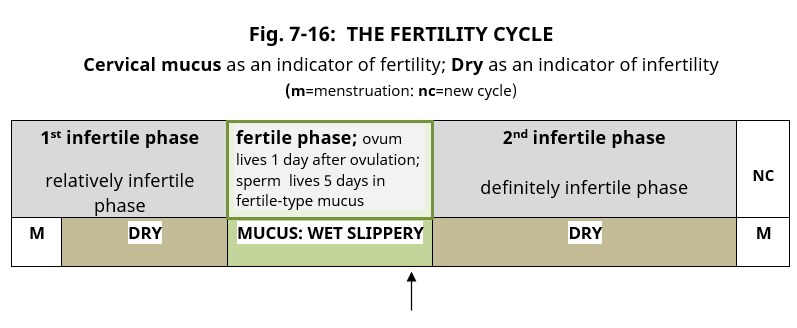
Are men and women always fertile?
The fertility of the couple is a shared fertility. The man is always fertile from puberty onwards for the rest of his life.1 The fertility of the woman is cyclical, this means the woman is fertile for just some days in the menstrual cycle, i.e. on those 6 days or so which lead up to the release of the ovum from the ovary into the fallopian tube, (i.e. ovulation), and for a few hours after ovulation.
NOTE: By learning fertility awareness and natural family planning (NFP) the woman can learn to identify these fertile days in her cycle.

The reproductive cells: sperm & ovum
The reproductive cell is known as the gamete. The gamete differs from other cells in the body as its nucleus contains just 23 chromosomes, while all other cell nuclei contain 46 chromosomes. The chromosomes carry DNA, the genetic material unique to each human being.
- The male gamete is the sperm and is produced by the male gonad, the testis. Sperm can survive for up to 5 days in fertile-type mucus which is present in the vagina during the 6 days or so leading up to ovulation.
- The female gamete is the ovum (egg) and is produced by the female gonad, the ovary. The ovum lives for 24 hours.
Menstrual Cycle
During the first phase (follicular phase) of each menstrual cycle a small number of immature eggs (follicles) start to mature under stimulation by follicle stimulating hormone (FSH) from the pituitary gland, and one follicle, (sometimes two follicles), continues to grow and becomes dominant. The dominant mature follicle is called the Graafian follicle and consists of the ovum (egg) surrounded by follicular fluid.
During the follicular phase, the oocyte (immature egg) increases in size from 15 micron to 135micron* when mature, to become the largest cell in the body as it has to sustain the pregnancy until implantation occurs seven days after fertilization.5 (*1 micron =0.001mm = one thousandth of a millimeter).
Ovulation
When the Graafian follicle has reached its maximum size (about 2.3cms due to the increase of follicular fluid), it ruptures, releasing the ovum into the outer end of the fallopian tube. This event is called ovulation and is triggered by luteinizing hormone from the pituitary gland, (the LH surge). The ovum lives for 24 hours after it is released and it is fertilizable for only 12-16 hours during those 24 hours. In Summary, Ovulation is the release of the mature ovum from the ovary into the outer end of the fallopian tube ready to be fertilized by the sperm. (Pictures & Diagrams, Fig 6-16, p15)
Where does fertilization occur?
Fertilization occurs at the outer end of the fallopian tube. (Pictures & Diagrams Fig.6-17, page 15.)
Fertilization
Fertilization is when the nucleus of the sperm and the nucleus of the ovum fuse together to become the first cell of a new human being.2 The fertilized ovum is known as the zygote, the first cell of a new individual, with his or her own unique DNA. In the nucleus of the zygote are the 46 chromosomes containing DNA, the genetic material, half of which comes from the mother and half from the father, 23 chromosomes from each parent. As stated by the late Professor of Genetics (Paris), Prof Jerome Lejeune,7 “All the information that is necessary for the development of that human being is contained in the zygote, this development is a continuous process from conception to birth and beyond.”
Implantation of the embryo
Implantation refers to the embedding of the embryo in the lining (endometrium) of the womb (uterus). After fertilization the embryo travels down the fallopian tube to the uterus and implantation occurs about seven days later in the endometrial lining of the uterus.4 (see Pictures & Diagrams Figs. 6-17/18, Pages 15, 16).
Embryo
Once the zygote divides it is known as the embryo. The term embryo refers to the conceptus from the division of the fertilized ovum to the 8th week after fertilization7
Fetus (Foetus)
At 8 weeks after fertilization the developing human being is no longer called an embryo, its name is changed to fetus which means something to be carried because the full form is already present.7 In summary, the term fetus (or foetus) refers to the conceptus at 8 completed weeks after fertilization until birth.
Why are the child-bearing years of the woman limited?
The testis continues to produce sperm throughout the adult life of the man. The woman will make no new ova after birth.3 This means that every girl when she is born already has the finite number of oocytes (called primordial follicles, immature eggs), to last her child-bearing years. A steady loss of oocytes from the ovary is occurring throughout the child-bearing years due to atresia or ovulation.6
The child-bearing years last about 35-40 years and the last menstrual cycle occurs when the quota of ova have been exhausted. This marks the arrival of the menopause. In fact even though the oocyte pool is depleted when the woman has reached menopause only about 300-400 ovulations will have occurred over the child-bearing years.4
References
- Odeblad Erik; The discovery of different types of cervical mucus and the Billings Ovulation Method; Bulletin of the Ovulation Method Research and Reference Centre of Australia, Vol 21, No 3; 3-35; Sept 1994. (online; google Erik Odeblad cervical mucus).
- Flynn, Anna; Brooks Melissa; The Manual of Natural Family Planning, p32; 1996; ISBN 0 7225 3115 X
- Lamb JF, Ingram CG, Johnson IA, Pitman RM; Essentials of Physiology; 3rd edition; p252; Blackwell Scientific Publications 1991; ISBN-632-03135-2.
- Griffin JE, Ojeda SR; Textbook of Endocrine Physiology 3rd Edition, 1996, p226; Oxford Univrsity Press, ISBN 0-19-510755-1 (pbk).
- Manassiev Nikolai, Whitehead, Malcolm; Female Reproductive Health; p7; 2004; ISBN 1-85070-491.
- Soules MR, Sherman S, Parrot E at al; Executive Summary; Stages of Reproductive Aging Workshop (STRAW); Fertil Steril; 2001; 76;874.
- Lejeune, Jerome; Davis v. Davis: Testimony; Child & Family; Vol 21, No 1; 1989-9; Ps 8-52.


